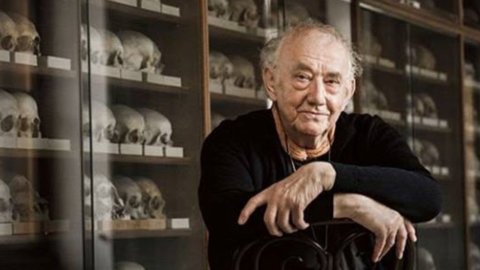The series of works on display consists of about thirty Tableaux Pièges executed by the artist in 2016 and entitled WAS BLEIBT (What Remains), made with objects recovered by Spoerri directly from the street at the end of the market day.
They are therefore the leftover objects, the scraps of scraps, those that apparently no longer interest anyone, not only those who originally got rid of them, but also those who, despite having seen them on the street for sale, left them there . However, Daniel Spoerri did not do this, tracking down, recovering and reinvesting attention even the last among the last objects.
All these objects, found by Daniel Spoerri in the markets, are presented here as if they had literally been taken from the asphalt in the same positions in which they lay.
In fact, the asphalt of the road still constitutes the support on which they are fixed, all preserved and blocked by the artist in an ideal collection, which is as much a reference to the gesture of collecting as to the idea of conservation as a trace and memory of situations experiences, traditions and customs that outline a sort of archaeological reconstruction of our time.
In this way Daniel Spoerri's works revolve around the idea of fixing forever what chance and life have naturally determined, as well as the manifestation of the artist's attempt to conserve, hold back and recirculate the traces and the memory of lived situations, of past traditions and customs. Memory and past life, their connections and the infinite stories that speak through these rejected and abandoned objects, thus outline a sort of archaeological and anthropological reconstruction of our time, relived through the creative practice of art.
They are "sentimental" objects, because it is as if they retained the past lives, and therefore ended, of those who owned and lived them (using and consuming them, venerating them, hating them, collecting them or even simply ignoring and abandoning them). The subjective value of each individual object remains "forgotten by heart" in the Tableau Piège, in which, however, two new factors are added: firstly, the invention of the artist and his taking from the street on the wall of the museum, secondly the ever-changing effect that each work and each collection of objects will have on the viewer, which will each time involve personal and certainly unprecedented meanings and associations as they were not foreseen by the artist at the beginning of his work. In this way, Daniel Spoerri's work has always been, from its beginnings and then in each of the innumerable variations he developed around the theme of the Tableau Piège up to the Was Bleibt cycle, a bridge between the artist's life and those of the others, lives evoked by the objects used in his dinners, or by those abandoned and finally rediscovered by the artist, with all the unexpected things these objects can evoke in each of us.





